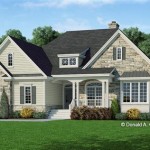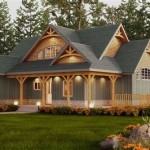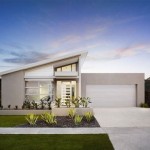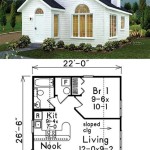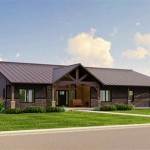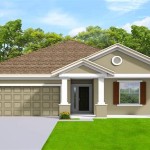Small Home Designs: Exploring Effective Floor Plans
The allure of small home designs lies in their efficient use of space, affordability, and reduced environmental impact. A well-designed floor plan is paramount to maximizing the livability and functionality of a smaller dwelling. Architects and designers focus on creating open, adaptable spaces that feel larger than their actual square footage. This article explores key considerations and strategies involved in developing effective floor plans for small home designs.
Prioritizing Functionality and Flow
The foundation of a successful small home floor plan is functionality. Every square inch must serve a purpose. This requires careful consideration of how the occupants will use each space and how those spaces will interact with one another. A logical and intuitive flow is essential to prevent the home from feeling cramped or awkward. Circulation paths should be direct and uncluttered, minimizing wasted space dedicated solely to movement.
One critical aspect of functionality is the strategic placement of essential amenities. The kitchen, bathroom, and bedroom(s) should be positioned to optimize convenience and privacy. For example, locating the bathroom near the living area and bedrooms is generally preferred. The kitchen, often considered the heart of the home, should be accessible and well-integrated with the living and dining areas, fostering a sense of connection and encouraging social interaction.
Beyond the placement of specific rooms, the overall layout needs to address the daily routines of the occupants. Consider how they will move through the home in the morning, during the day, and in the evening. This user-centric approach will help ensure that the floor plan supports their lifestyle and enhances their quality of life. For instance, incorporating a mudroom or entry area near the main entrance provides a designated space for removing shoes and outerwear, preventing clutter from accumulating in the living areas.
Multi-functional spaces are a cornerstone of effective small home design. A spare bedroom can double as a home office, a dining area can transform into a workspace, and the living room can serve as a guest bedroom with the aid of a sofa bed. This adaptability allows the home to cater to a variety of needs without sacrificing valuable square footage. Flexible furniture, such as nesting tables, folding chairs, and modular storage units, further enhances the versatility of these spaces.
Optimizing Space with Open Concepts and Vertical Strategies
Open-concept layouts are frequently employed in small home designs to create a sense of spaciousness and visual connectivity. By eliminating walls between the living room, dining room, and kitchen, designers can create a single, flowing space that feels larger than the sum of its parts. This approach also allows for better natural light distribution, further enhancing the sense of openness.
However, open-concept layouts also present challenges. It is important to define distinct zones within the open space to prevent it from feeling chaotic or undefined. This can be achieved through the strategic use of furniture placement, area rugs, changes in flooring material, and subtle variations in ceiling height. For example, a large area rug can delineate the living room area, while a kitchen island can separate the cooking area from the dining space.
In addition to horizontal space optimization, vertical strategies are crucial for maximizing the potential of a small home. Utilizing vertical space through the incorporation of high ceilings, loft spaces, and strategically placed storage solutions can significantly expand the usable area. High ceilings create a sense of airiness and allow for the installation of tall windows, maximizing natural light penetration.
Loft spaces, often accessed by a ladder or narrow staircase, can serve as bedrooms, home offices, or storage areas. These elevated spaces provide a separate and private area without requiring a significant footprint. Built-in storage solutions, such as shelving units that extend to the ceiling and under-stair storage compartments, are essential for maximizing storage capacity without cluttering the living areas.
The strategic use of furniture can also contribute to vertical space optimization. Tall bookshelves, vertical gardens, and hanging storage solutions can all help to maximize storage capacity and create visual interest without taking up valuable floor space.
Incorporating Natural Light and Ventilation
Natural light and ventilation are essential elements of any successful home design, but they are particularly important in small homes. Ample natural light can make a small space feel larger, brighter, and more welcoming. Proper ventilation ensures a healthy and comfortable indoor environment by removing stale air and preventing the buildup of moisture and pollutants.
Large windows, skylights, and strategically placed doors can all contribute to maximizing natural light penetration. South-facing windows are generally the most effective for capturing sunlight throughout the day. However, it is important to consider the potential for overheating in warmer climates. Overhangs, awnings, and window coverings can help to mitigate this issue.
The placement of windows should also consider the views from the home. Framing scenic views can create a sense of connection to the outdoors and enhance the overall living experience. However, it is important to balance the desire for views with the need for privacy. The use of frosted glass, strategically placed landscaping, and window coverings can help to achieve this balance.
Cross-ventilation, which involves opening windows on opposite sides of the home to create a natural airflow, is an effective way to improve ventilation and reduce reliance on air conditioning. The placement of windows and doors should be carefully considered to optimize cross-ventilation. Operable skylights can also contribute to ventilation by allowing warm air to escape from the upper levels of the home.
In addition to natural ventilation, mechanical ventilation systems, such as exhaust fans in the kitchen and bathrooms, are essential for removing moisture and odors. These systems should be properly sized and installed to ensure effective ventilation.
The incorporation of natural light and ventilation is not only beneficial for the occupants' well-being but also contributes to the overall energy efficiency of the home. By reducing reliance on artificial lighting and air conditioning, homeowners can lower their energy bills and reduce their environmental impact.
Ultimately, successful small home design requires a thoughtful and holistic approach that considers functionality, space optimization, and environmental factors. By prioritizing these elements in the floor plan development process, architects and designers can create compact and comfortable living spaces that cater to the needs of modern homeowners.

Small House Design 2024005 Pinoy Eplans Modern Plans Layout

Floorplan Image For Plan Small House Plans Floor Tiny

10 Small House Plans With Open Floor Blog Homeplans Com
Small Homes Top 5 Floor Plans Designs For Houses Architecture Design

Free Home Plans Off The Grid House Design Floor Tiny Simple

10 Small House Plans With Open Floor Blog Homeplans Com

Small House Plans With S Houseplans Blog Com

10 More Small Simple And House Plans Blog Eplans Com

Element Exclusive Switch Homes Narrow House Designs Home Design Floor Plans Small

10 Small House Plans With Open Floor Blog Homeplans Com


